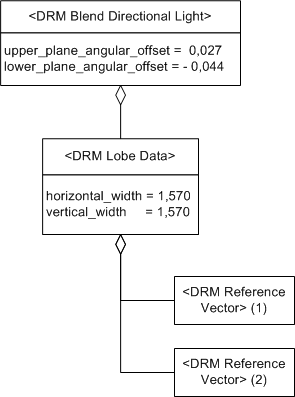For an airplane approaching a runway, the colour of the approach lights can change depending on the relationship of the airplane to the correct approach slope as depicted in Figure 6.1.
This can be represented by a <Blend Directional Light> instance having both a primary and a secondary colour as depicted in Figure 6.2.
If the position of the observer is 0.177 radians (approximately 10 degrees) above the SE_REFVEC_LIGHT_DIRECTION vector of the <Lobe Data> instance, the observer will see the primary colour.
If the position of the observer is 0.027 radians (approximately 1.5 degrees) above the SE_REFVEC_LIGHT_DIRECTION vector, the observer will see the primary colour, since the observer is at the upper edge of the blend section. As the observer moves lower, the amount of primary colour decreases as it is blended with proportionally increasing amounts of the secondary colour. Once the observer reaches -0.009 radians (approximately -0.5 degrees) from the SE_REFVEC_LIGHT_DIRECTION vector in the vertical direction (i.e., towards the negative end of the SE_REFVEC_VERTICAL_AXIS vector), the observer sees the primary and secondary colours blended in equal amounts as the observer is now in the middle of the blend section. As the observer continues to move in the same direction, the amount of primary colour continues to decrease proportionally as the amount of secondary colour increases. When the observer reaches -0.044 radians (approximately -2.5 degrees) from the SE_REFVEC_LIGHT_DIRECTION vector, the observer sees only the secondary colour, as he has now reached the lower edge of the blend section.
If the position of the observer from the SE_REFVEC_LIGHT_DIRECTION vector is -0.177 radians (approximately -10 degrees) in the vertical direction (i.e., towards the negative end of the SE_REFVEC_VERTICAL_AXIS vector), the secondary colour is seen as the observer is inside the vertical width, in the lower section of the cone.
If the position of the observer from the SE_REFVEC_LIGHT_DIRECTION vector is -0.884 radians (approximately -50 degrees) in the vertical direction (i.e., towards the negative end of the SE_REFVEC_VERTICAL_AXIS vector), nothing is seen as the observer is outside the pyramid.

